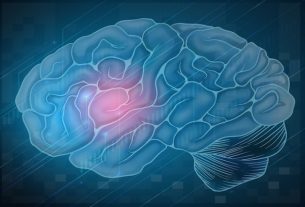A cerebral aneurysm is a weak or thin point in a blood vessel in the brain, which increases the risk of rupture, as the wall of the artery dilates and fills with blood, which can result in a hemorrhagic stroke, which can be more or less less severe, depending on the size of the bleeding and the affected region of the brain.
In most cases, a brain aneurysm that has not ruptured does not cause any symptoms. However, when it ruptures, it can cause an extremely intense headache that is sudden or increases over time, and can be accompanied by nausea, vomiting or loss of consciousness.
The treatment of a brain aneurysm is carried out by a neurologist, and medication may be indicated to regulate blood pressure and prevent the aneurysm from rupturing, or surgery, which is most often indicated for cases of aneurysms that have already ruptured, but can also be performed to treat specific aneurysms, depending on their location and size.

Brain aneurysm symptoms
The main symptoms of brain aneurysm are:
- Very intense headache, which starts suddenly;
- Nausea or vomiting;
- Neck stiffness or lower back pain when flexing the neck;
- Blurred or double vision;
- Drooping eyelids;
- Increased sensitivity to light;
- Drowsiness, mental confusion, loss of consciousness or fainting;
- Seizures, in some cases.
These symptoms may appear when the aneurysm ruptures, causing bleeding in the brain, and in some cases, the person may also have a sensation that the head is hot and that there is a “leak” and that it appears that the blood has spread.
In addition, generally people who have high blood pressure and a brain aneurysm may experience a sudden or intense headache about 6 to 20 days before the aneurysm ruptures, due to a small hemorrhage or blood leak in the brain.
However, a brain aneurysm usually does not cause any symptoms and is identified accidentally during a diagnostic examination of the head. However, some people with an aneurysm may experience signs such as constant pain behind the eye, dilated pupils, double vision, or tingling in the face.
When symptoms of a brain aneurysm appear, and whenever there is a suspicion of a rupture, it is very important to immediately call for medical help by dialing 911, or take the person immediately to the hospital to begin the most appropriate treatment.
How to confirm the diagnosis
The diagnosis of cerebral aneurysm is made by a neurologist through the evaluation of symptoms and imaging tests, such as computed tomography angiography, magnetic resonance imaging or angiography, to evaluate the structures of the brain and identify whether there is any dilation in the blood vessels or rupture of the aneurysm.
Make an appointment with a neurologist in the region closest to you:
Taking care of your health has never been easier!
Computed tomography is an extremely useful exam with very high sensitivity when performed within 6 hours of the onset of cerebral aneurysm symptoms.
If the computed tomography gives a negative result and the doctor still suspects subarachnoid hemorrhage, a lumbar puncture may be requested to evaluate the cerebrospinal fluid surrounding the brain and spinal cord, and thus confirm the diagnosis.
These tests also help the doctor to rule out other conditions with similar symptoms, such as malformations in cerebral blood vessels, cerebral venous thrombosis, migraine, cluster headache or rupture of the carotid artery, for example.
Possible causes of aneurysm
A cerebral aneurysm is caused by a thinning of the wall of cerebral blood vessels, which can result in their dilation, as if a bubble were forming in the artery, increasing the risk of rupture and the appearance of symptoms.
Some factors can increase the risk of developing a brain aneurysm, such as:
- Age, being more common in the elderly;
- Uncontrolled high blood pressure;
- Smoking habit;
- Excessive and frequent consumption of alcoholic beverages;
- Atherosclerosis;
- Use of drugs of abuse, such as cocaine;
- Brain tumor or trauma;
- Family history of aneurysms.
Additionally, some genetic conditions also appear to increase the risk of brain aneurysm, such as polycystic kidney disease, tuberous sclerosis, Ehlers-Danlos syndrome, fibromuscular dysplasia, or cerebral blood vessel malformations.
How the treatment is carried out
Aneurysm treatment is quite variable and may depend not only on health history, but also on the size of the aneurysm and whether or not it is leaking. Thus, the most used treatments include:
1. Unruptured aneurysm
Most of the time, doctors choose not to treat unruptured aneurysms, as the risk of them rupturing during surgery is very high. Therefore, it is normal to regularly assess the size of the dilation to ensure that the aneurysm is not increasing in size.
In addition, medications may also be prescribed to alleviate some of the symptoms, such as Paracetamol, Dipyrone, Ibuprofen, to reduce headaches or Levetiracetam, to control the emergence of seizures, for example.
However, in some cases the neurologist may choose to perform endovascular surgery with placement of stentto prevent rupture, however, as it is a very delicate procedure, due to the risk of rupture during the procedure, it needs to be very well evaluated and the risks must be well explained to the patient and family.
2. Ruptured aneurysm
When an aneurysm ruptures, it is a medical emergency and, therefore, you must go to the hospital immediately to begin appropriate treatment, which is normally done with surgery to close the vessel that is bleeding inside the brain. The sooner treatment is carried out, the lower the chances of developing lifelong consequences, as the smaller the area of the brain will be affected.
When the aneurysm ruptures, it causes symptoms similar to those of a hemorrhagic stroke. See what signs you should look out for.
Possible sequelae of aneurysm
A cerebral aneurysm can cause a subdural hematoma, a hemorrhage called subarachnoid, which is the bleeding between the brain and the meninges that cover it, or cause intracerebral hemorrhage, which is the bleeding that occurs in the middle of the brain.
After an aneurysm, a person may not have any consequences, but some may present neurological changes similar to those of a stroke, such as difficulty in lifting an arm due to lack of strength, difficulty speaking or slowness in thinking, for example. People who have already had an aneurysm have a higher risk of suffering a new event.
See other possible consequences that may arise when there is a change in the brain.

Sign up for our newsletter and stay up to date with exclusive news
that can transform your routine!



